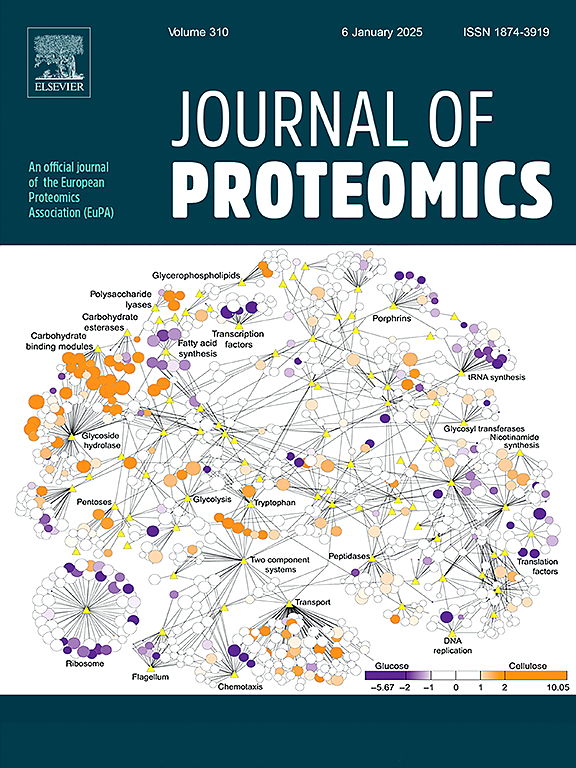黄颡鱼毒液的综合转录组学、蛋白质组学、生化和中和研究。
IF 2.8
2区 生物学
Q2 BIOCHEMICAL RESEARCH METHODS
引用次数: 0
摘要
小腹蛇属的物种属于Elapidae科,拥有具有重要临床意义的毒液。本研究提出了一种毒液组成的分析,利用转录组学和蛋白质组学的方法。共组装了2885个毒腺转录本,其中42个被鉴定为毒素。三指毒素(3FTx)转录本最多(80.7 %),其次是PLA2转录本(16.3 %)。通过自下而上的霰弹枪MS/MS毒液分析获得的色氨酸序列与SwissProt/UniProt数据库中的46个不同的蛋白相匹配,其中23个属于3FTx家族。与毒腺转录组数据库进行肽谱匹配,鉴定出24个蛋白,其中12个对应于3FTx, 3个属于PLA2。通过RP-HPLC对毒液进行分解,然后对部分进行n端氨基酸测序,可以估计蛋白质家族的相对丰度,表明3FTx占毒液的50% %以上。已确定的毒性组分在小鼠中显示出明显的致命性特征,某些组合表现出增强的毒性,与已报道的褐毒素- 1非常相似,只有PLA2序列显示相似。我们的研究结果强调了整合转录组学和蛋白质组学方法来理解毒液多样性及其对抗蛇毒血清发育的影响的重要性。意义:墨西哥的蛇毒多样性在美洲排名第一。矛盾的是,人们对珊瑚蛇毒液的成分知之甚少,而Micrurus ephippifer就是一个明显的例子,因为人们对它的毒液成分一无所知。这种类型的研究提供了有价值的信息,有助于填补这些知识空白。本研究是第二次报道含有磷脂酶A2和三指毒素复合物的珊瑚蛇毒,为进一步研究了解蛇毒进化和评估抗蛇毒血清的功效提供了重要数据。本文章由计算机程序翻译,如有差异,请以英文原文为准。

Integrative transcriptomic, proteomic, biochemical and neutralization studies on the venom of Micrurus ephippifer
Species of the genus Micrurus belong to the family Elapidae and possess venoms of significant clinical importance. This study presents an analysis of the venom composition of Micrurus ephippifer, employing transcriptomic and proteomic methodologies. A total of 2885 venom gland transcripts were assembled, of which 42 were identified as toxins. Transcripts for three-finger toxins (3FTx) were the most abundant (80.7 %), followed by PLA2 transcripts (16.3 %). Tryptic peptide sequences obtained through bottom-up shotgun MS/MS venom analysis were assigned to 46 distinct proteins in the SwissProt/UniProt database, of which 23 belong to the 3FTx family. Peptide spectral matching against the venom gland transcriptome database identified 24 proteins, 12 of which correspond to 3FTx, and three belong to PLA2. Venom decomplexation by RP-HPLC followed by N-terminal amino acid sequencing of fractions allowed an estimation of the relative abundance of protein families, indicating that 3FTx comprise over 50 % of the venom. The identified toxic fractions displayed distinct lethality profiles in mice, with certain combinations exhibiting enhanced toxicity, very similar to what has been reported with Brownitoxin-I, with only the PLA2 sequence showing similarity. Our results emphasize the importance of integrating transcriptomic and proteomic approaches to understand venom diversity and its implications for antivenom development.
Significance
Mexico ranks first in the Americas in snake venom diversity. Paradoxically, very little is known about the composition of coral snake venoms, and Micrurus ephippifer is a clear example of this gap, as nothing was known about its venom composition. This type of study provides valuable information that helps fill these knowledge gaps. This study presents the second report of coral snake venoms containing a complex of phospholipase A2 and a three-finger toxin, offering important data that, with further research, will contribute to understanding venom evolution and evaluating the efficacy of antivenoms.
求助全文
通过发布文献求助,成功后即可免费获取论文全文。
去求助
来源期刊

Journal of proteomics
生物-生化研究方法
CiteScore
7.10
自引率
3.00%
发文量
227
审稿时长
73 days
期刊介绍:
Journal of Proteomics is aimed at protein scientists and analytical chemists in the field of proteomics, biomarker discovery, protein analytics, plant proteomics, microbial and animal proteomics, human studies, tissue imaging by mass spectrometry, non-conventional and non-model organism proteomics, and protein bioinformatics. The journal welcomes papers in new and upcoming areas such as metabolomics, genomics, systems biology, toxicogenomics, pharmacoproteomics.
Journal of Proteomics unifies both fundamental scientists and clinicians, and includes translational research. Suggestions for reviews, webinars and thematic issues are welcome.
 求助内容:
求助内容: 应助结果提醒方式:
应助结果提醒方式:


